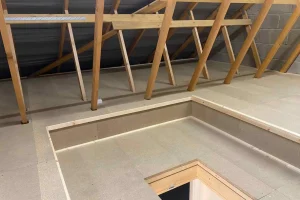Loft boarding is a savvy solution for maximizing space in homes with loft areas. By installing boards over joists, homeowners can create usable flooring, transforming previously wasted space into valuable storage or living space. However, to ensure loft boarding remains safe and functional, regular maintenance is essential.
Initial Installation Considerations
Before diving into maintenance, it’s crucial to start with proper installation. Choose loft boarding materials that are sturdy and appropriate for your needs. Whether you opt for chipboard, plywood, or another material, ensure it’s compatible with your loft’s structure. Proper installation techniques, such as evenly spacing boards and securing them firmly to joists, are imperative for long-term stability.
Regular Cleaning and Inspection
Regular maintenance begins with cleaning and inspection. Dirt, dust, and debris can accumulate over time, compromising the integrity of the boards. Regularly sweep or vacuum the surface to remove any buildup. Additionally, inspect the boards for signs of damage, such as warping, cracking, or loose fittings. Addressing issues promptly can prevent further deterioration and ensure safety.
Regular cleaning and inspection are fundamental aspects of maintaining loft boarding. This section delves deeper into why these tasks are essential and provides practical tips for carrying them out effectively.
Importance of Regular Maintenance:
Loft boarding, like any other part of a home, accumulates dirt, dust, and debris over time. This buildup not only detracts from the aesthetic appeal but can also compromise the structural integrity of the boards. Regular cleaning helps remove surface contaminants, preventing them from embedding into the material and causing damage. Additionally, frequent inspection allows homeowners to identify and address any issues before they escalate into larger problems, ensuring the safety and longevity of the loft space.
Cleaning Loft Boarding Surfaces:
Cleaning loft boarding surfaces is a straightforward yet crucial task. Begin by sweeping the surface with a soft-bristled broom or using a vacuum cleaner with a brush attachment to remove loose debris. Pay special attention to corners and edges where dust and dirt tend to accumulate. For more stubborn stains or buildup, dampen a cloth or mop with a mild detergent solution and gently scrub the affected areas. Avoid using harsh chemicals or abrasive cleaners, as they can damage the surface of the boards.
Checking for Signs of Damage or Wear:
Alongside cleaning, regular inspection is vital for detecting signs of damage or wear. Start by visually examining the entire surface of the loft boarding, looking for any visible cracks, warping, or discoloration. Run your hands over the boards to feel for any areas that may be uneven or soft, indicating potential water damage or rot. Listen for any creaking or squeaking sounds when walking on the boards, as these may indicate loose fittings or underlying structural issues. Additionally, inspect the area around the perimeter of the loft for any signs of pests or wildlife intrusion, such as droppings or chew marks.
Addressing Issues Promptly:
If during the inspection you discover any signs of damage or wear, it’s crucial to address them promptly. Small cracks or gaps can be filled with wood filler or sealant to prevent further deterioration. Loose fittings should be tightened or replaced as needed to ensure the stability of the boards. For more significant issues such as water damage or structural instability, consult a professional for expert assessment and repair. By addressing problems early on, you can prevent them from worsening and prolong the lifespan of your loft boarding.

Preventing Moisture Damage
Moisture is a common enemy of loft spaces, posing a risk of mold, rot, and structural damage. Proper ventilation is crucial for maintaining optimal humidity levels. Ensure vents are unobstructed and consider installing additional vents if necessary. Moisture barriers, such as vapor barriers or sealants, can provide an extra layer of protection against moisture infiltration.
Reinforcing Weak Areas
Over time, certain areas of loft boarding may weaken due to heavy loads or structural issues. Identify weak points by inspecting for sagging or creaking boards. Reinforce these areas by adding additional supports or reinforcing joists. Repair any damaged sections promptly to prevent further deterioration and maintain overall structural integrity.
As loft boarding ages or undergoes heavy use, certain areas may weaken over time. Identifying and reinforcing these weak areas is crucial to maintaining the structural integrity and safety of the loft space. This section provides detailed guidance on how to recognize weak points and effectively reinforce them.
Identifying Weak Points:
Weak areas in loft boarding can manifest in various forms, such as sagging or bowing boards, creaking or squeaking sounds when walking on the surface, or visible signs of damage such as cracks or splits. Additionally, areas that experience heavy foot traffic or are subjected to concentrated weight loads, such as near-access hatches or storage areas, are more prone to weakening over time. By inspecting the loft boarding regularly, homeowners can identify these weak points and take proactive measures to reinforce them before they escalate into larger problems.
Strengthening Supports and Joists:
One of the most common causes of weak areas in loft boarding is inadequate support or reinforcement of joists. If joists are not properly spaced or are undersized for the load they bear, they may begin to sag or bow under pressure. Strengthening supports and joists involves adding additional beams or braces to distribute weight more evenly and provide greater stability. This can be achieved by installing support beams perpendicular to existing joists or adding metal brackets or hangers for extra reinforcement. Additionally, reinforcing existing joists with sister joists—new joists attached alongside existing ones—can help shore up weak areas and prevent further sagging or bowing.
Repairing Damaged Sections:
In addition to reinforcing supports and joists, it’s essential to repair any damaged sections of loft boarding promptly. Small cracks or splits can be filled with wood filler or epoxy resin to prevent further deterioration and restore structural integrity. Loose or damaged boards should be securely fastened or replaced as needed to ensure a stable and level surface. When replacing boards, be sure to use materials of similar thickness and quality to maintain uniformity and compatibility with existing boards.
Professional Assessment and Repair:
In cases where weak areas are extensive or structural issues are severe, it may be necessary to seek professional assistance. Structural engineers or experienced contractors can assess the condition of the loft boarding and recommend appropriate reinforcement or repair measures. This may involve more extensive renovations, such as installing additional support beams or reinforcing the loft’s subflooring. While professional repairs may incur additional costs, they are essential for ensuring the safety and longevity of the loft space.
Insulating Loft Boarding
Proper insulation is key for energy efficiency and comfort. Insulating the space between loft boards and the ceiling below helps regulate temperature and reduce heat loss. Choose insulation materials that are appropriate for your climate and install them according to manufacturer guidelines. Proper insulation not only improves energy efficiency but also helps prevent condensation and moisture buildup.
Safeguarding Against Pests
Loft spaces can attract unwanted pests such as rodents, insects, and birds. Implement pest prevention measures such as sealing entry points, using pest deterrents, and regularly inspecting for signs of infestation. If pests are present, take swift action to address the problem and prevent damage to loft boarding and stored items.
Utilizing Storage Solutions
One of the primary benefits of loft boarding is the additional storage space it provides. Maximize this space by using storage bins, shelves, and organizers. Keep items organized and labeled for easy access. Avoid overloading the space with heavy items to prevent strain on the boards and joists.
One of the primary advantages of loft boarding is the additional storage space it provides. Effectively utilizing this space requires strategic planning and organization. This section explores various storage solutions and offers practical tips for maximizing storage capacity in the loft area.
Maximizing Storage Space:
Before implementing storage solutions, it’s essential to assess the available space and identify areas where storage can be maximized. Utilize the entire loft area, including corners, alcoves, and under eaves, to make the most of the available square footage. Consider the layout of the space and the types of items you plan to store to determine the most efficient storage solutions for your needs.
Using Storage Bins and Containers:
Storage bins and containers are versatile storage solutions that can help keep the loft area organized and clutter-free. Choose bins and containers of various sizes to accommodate different types of items, from seasonal clothing and bedding to holiday decorations and keepsakes. Transparent bins allow for easy identification of contents, while stackable bins help maximize vertical space. Labeling bins with their contents can further streamline organization and retrieval of items.
Installing Shelving Units:
Shelving units are an excellent option for storing items that are frequently accessed or need to be displayed. Install shelving units along walls or in alcoves to take advantage of vertical space while keeping the floor area clear. Adjustable shelves allow for customization to accommodate items of different sizes, while wall-mounted shelves provide additional floor space for larger items or furniture.
Utilizing Hanging Storage:
Hanging storage solutions, such as hooks, racks, and hanging organizers, are ideal for keeping frequently used items within easy reach. Install hooks on walls or beams to hang coats, bags, and accessories. Use overhead racks or pulley systems to store bicycles, sports equipment, or seasonal items. Hanging organizers with compartments or pockets are perfect for storing small items like tools, craft supplies, or toys.
Organizing Items for Easy Access:
Effective organization is key to maximizing storage space and maintaining a clutter-free environment. Group similar items together and assign designated storage areas for each category, such as clothing, bedding, holiday decorations, and household supplies. Keep frequently used items within arm’s reach and less frequently used items towards the back or higher shelves. Use storage bins, baskets, or drawer dividers to keep smaller items organized and prevent them from getting lost or misplaced.
Optimizing Accessibility:
Accessibility is essential when utilizing loft storage solutions, especially for items that are accessed frequently or seasonally. Consider installing access hatches or pull-down ladders for easy entry and exit to the loft area. Store frequently used items near access points for quick retrieval, while seasonal or infrequently used items can be stored towards the back or higher shelves.
Repairing and Replacing Loft Boards
Despite regular maintenance, loft boards may eventually require repair or replacement. Signs such as severe warping, water damage, or structural instability indicate the need for immediate attention. Depending on the extent of the damage, repairs can range from simple fixes to more extensive renovations. When in doubt, consult a professional to ensure proper repair and maintenance.
Maintaining loft boarding is essential for maximizing its longevity and functionality. By following these tips and guidelines, homeowners can ensure their loft spaces remain safe, efficient, and functional for years to come. Regular cleaning, inspection, reinforcement, and repair are key to preserving the integrity of loft boarding and enjoying its benefits to the fullest



